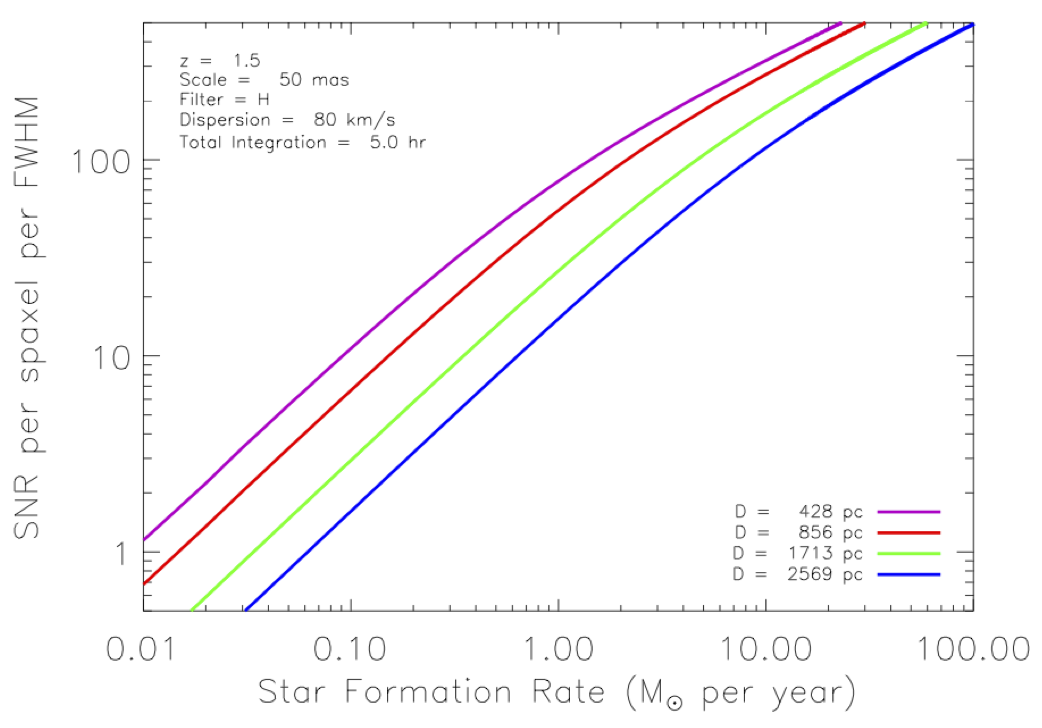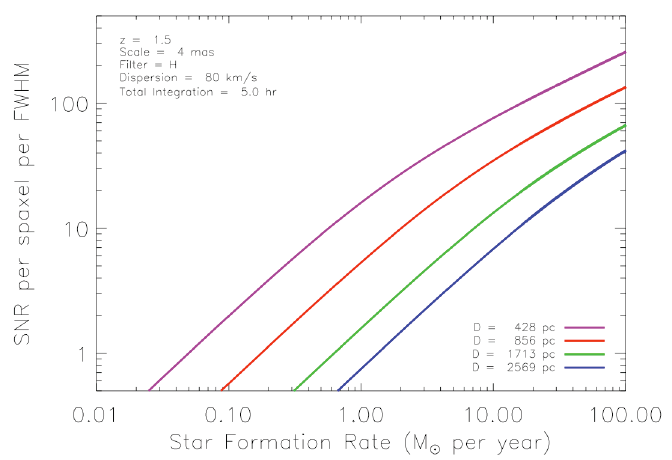High-z Galaxy Dynamics and Morphologies: Studying the epoch of galaxy formation
A major scientific breakthrough of IRIS+NFIRAOS will be the spatial dissection of galaxies in the early universe in the range of z~ 1-5 (look back time of 7.5 - 12.5 Gyr), which is during the the peak of the cosmic star formation and Active Galactic Nuclei (AGN) accretion history of the universe. Observations of these galaxies with the TMT will exploit both the light gathering power and the unique angular resolution at near-infrared wavelengths provided by the adaptive optics system. Large samples of galaxies throughout this redshift range are already known, and the current generation of 8-10 m telescopes has recently provided intriguing evidence for prevalent dynamically ‘hot’ high-velocity dispersion systems that do not fit neatly into our current picture of galaxy formation.
Spatially resolved spectroscopy of emission lines with the light-gathering power and spatial resolution of TMT will allow differences in chemistry, kinematics, and physical conditions to be mapped as a function of spatial position within the galaxies. Such information is required to go beyond measurements of crude global properties, and thereby gain fresh understanding into the physics of galaxy formation. IRIS, with its imaging and IFU capabilities, will provide the crucial first steps in a comprehensive survey of both massive and low mass systems. It will measure velocity widths and global rotation of galaxies, helping to distinguish kinematics associated with ongoing merging signatures from kinematics of rapidly star-forming but otherwise undisturbed galaxies. By measuring emission line ratios as a function of position within the galaxies, IRIS will uncover active galactic nuclei that might otherwise be hidden, and it will probe the spatial evolution of metallicity gradients within galaxies, which are closely tied to their formation mechanisms.

Relative signal-to-noise ratios expected for a two-hour observation of H-alpha emission from the star-forming galaxy HDF-BX1564 with current 10m (left-hand panel) and next-generation 30m (right-hand panel) facilities. Note the key increase in the ability to detect low surface brightness emission on small angular scales between the two galaxy components.
Simulations of expected sensitivity
Simulations of the sensitivity of the IRIS imager and spectrograph were performed for both the point source sensitivity and the expected spectroscopy sensitivity to emission lines for high-z galaxies. These simulations are based on expected instrument noise characteristics and typical sky background and AO performance estimates for TMT. In particular, these simulations show that IRIS will be able to detect normal star forming galaxies at high-z, compared the current capabilities of 8-10 meter class telecopes, which can only detect the most massive galaxies with the highest star formation rates. Star forming galaxies currently being studied on 8-10m telescopes typically have total integrated star formation rates of 10-100 Msun/yr, stellar masses of 1e9-1e11 Msun, and dark matter halo masses of 1e11-1e13 Msun. In comparison, the 0.05" scale of IRIS will allow observations of z=1.5 star forming galaxies with integrated star formation rates of 0.1 - 10 Msun/yr. The figures below highlight the capabilities of IRIS on a z~1.0 galaxy and z~5.0 galaxy, illustrating the signal-to-noise achieved given a SFR and surface brightness profile of these example galaxies. In addition we show the signal-to-noise achieved for a range of surface brightness profiles and velocity dispersions observed with both the 0.004" and 0.05" spatial scale.
(Left) Integrated signal-to-noise ratio (SNR) for a z=1.0 (look-back time 7.7 Gyr) simulated galaxy's Ha emission redshifted into J band with an integrated star formation rate of 5 M_sun yr-1 and an intrinsic velocity dispersion of 80 km s-1. Total integration time is 5 hours, with 20 stacked 900 second exposures. Note the diffuse region and the secondary object ~20 kpc away from the primary galaxy (blue-purple) that can be detected using IRIS in the coarsest scale (0.05"). (Right) Star Formation Rate (SFR; M_sun yr-1) spatially distributed across the galaxy.
(Left) Integrated signal-to-noise ratio for a z=5.0 (look-back time 12.5 Gyr) simulated galaxy's [OII] emission redshifted into K band with an integrated star formation rate of 30 M_sun yr-1 and intrinsic velocity dispersion of 80 km s-1. Total integration time is 5 hours, with 20 stacked 900 second exposures. (Right) Star Formation Rate (SFR; M_sun yr-1) spatially distributed across the galaxy.

Estimated signal-to-noise ratio per spaxel per FWHM in the 0.05" integral field spectrograph scale for Ha emission of a z=1.5 (look back time 9.3 Gyr) galaxy versus star formation rate (M_sun yr-1) for a range of flux distribution sizes (angular diameters 0.05", 0.1", 0.2", and 0.3") and a fixed intrinsic velocity dispersion (80 km s-1). A total integration time of 5 hours was made up of single exposures of 900 seconds stacked 20 times in H. At 0.05" spatial scales IRIS will be able to observe z=1.5 galaxies with star formation rates of less than 1 M_sun yr-1 with sufficient signal-to-noise.

Estimated signal-to-noise ratio per spaxel per FWHM versus star formation rate for Ha emission in the 0.004" integral field spectrograph scale of a z=1.5 (look back time 9.3 Gyr) galaxy given a range of flux distribution sizes (angular diameters 0.05", 0.1", 0.2", and 0.3") and a fixed intrinsic velocity dispersion (80 km s-1). A total integration time of 5 hours was made up of single exposures of 900 seconds stacked 20 times in H broadband. At the 0.004" spatial scale IRIS will be able to observe z=1.5 galaxies with star formation rates of 5 - 100 M_sun yr-1 with sufficient signal-to-noise.
For more information:
Material for this webage is adapted from:
- Wright, S. et al. 2010, The infrared imaging spectrograph (IRIS) for TMT: sensitivities and simulations
- The TMT Detailed Science Case (PDF)
- IRIS InfraRed Imaging Spectrograph Concept Design Study Report